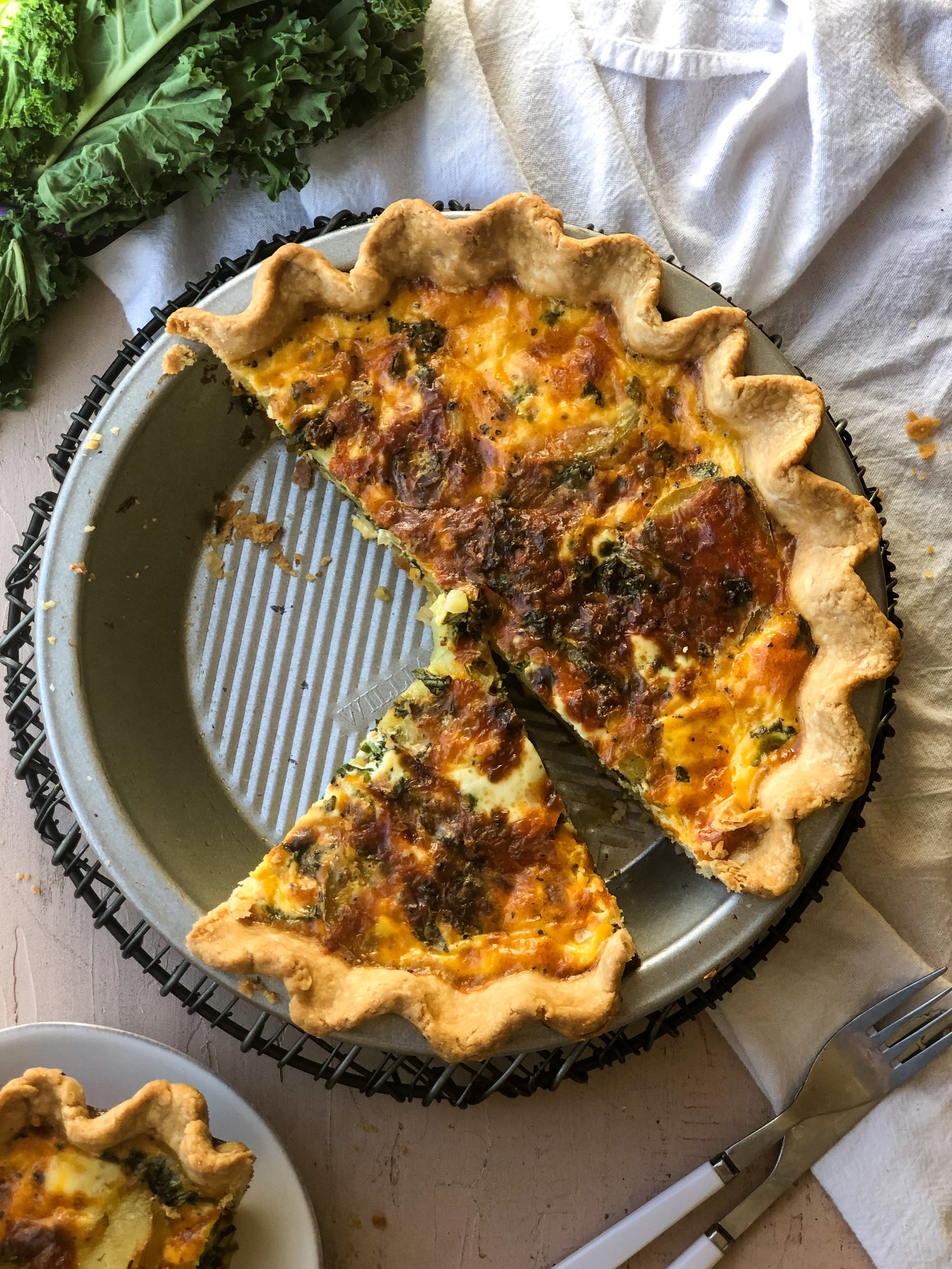Potato, Cheddar and Kale Quiche
When discussing holiday traditions at work, one of my coworkers mentioned that her grandma always bakes a quiche on Christmas. She isn't sure where or why this custom originated, but her grandma only bakes one quiche each year on Christmas day. Personally, as someone who has very little quiche experience, but has always been quiche-curious, the concept of “Christmas quiche" presented the perfect opportunity to test this dish.
I wanted to keep the flavors in this quiche crowd-pleasing and straightforward, so you could easily serve it at a holiday breakfast or brunch. Potatoes, kale and cheddar cheese are the most prominent ingredients in this quiche, along with some onion and garlic. These ingredients are all in-season and might even be in your cabinet right now!
Let me know what you think of the recipe and don’t forget to follow the sustainability tips below!
Time: 3 1/2 hours
Makes: 1 quiche
Serves: 6-8 people
Ingredients
For the Dough
1¼ cups all-purpose flour, plus more for dusting
½ teaspoon kosher salt
½ cup (1 stick) cold unsalted butter, chopped into small cubes
3 tablespoons ice-cold water
1 tablespoon apple cider vinegar
For the Filling
2 cloves garlic, minced
1 medium yellow onion
1 large or 3 small golden potatoes, about 2 cups sliced
1/2 bunch of kale, or about 2 loosely packed cups
1 cup shredded sharp cheddar cheese
2 large eggs
1/2 cup milk
1/2 cup light cream
1 teaspoon salt
Steps
For the Dough
Whisk together the flour and salt in a large bowl, or in a stand mixer fitted with a paddle attachment. Add the cold chopped butter. Start the mixer on medium-low speed (or use your fingers) to break the butter into pea-sized pieces. Add the water and ACV and mix until combined.
Transfer the dough to a lightly floured countertop. Use a rolling pin to whack/roll out the dough, keeping it as circular as you can, until it reaches about 12 inches in diameter. Gently pick up the dough and place it into a 9-inch pie pan. Gently form the dough to the bottom and edges of the pan. Tuck the overhanging dough under itself, leaving about 1/2-inch of dough above the top of the pie pan. Then use your fingers to shape the edges into a crimp pattern. Place the shaped crust in the freezer for about 15 minutes.
After 15 minutes, remove the crust from the freezer and place the crust (still inside the pie pan, of course) onto a baking sheet. Place a large sheet of aluminum foil or parchment paper inside the crust and fill it with dried rice or beans, granulated sugar, or pie weights. Bake the crust for 30-40 minutes, or until lightly golden brown all over. This short bake is called a blind bake and will help ward away any soggy pie bottoms.
For the Fillings
Preheat oven to 350 F. Slice the potatoes into 1/4-inch thick rounds, dice the onion and tear the kale into 1-inch pieces.
Pour 2 tablespoons of olive oil into a large skillet over medium heat. Place the potatoes into the skillet and let cook until beginning to brown, about 5 minutes. Toss minced garlic and onion into the skillet and let saute, stirring occasionally, until onions are translucent, about 5 more minutes. Then, add the kale to the skillet and saute until wilted. Transfer the mixture to a large bowl and set aside to cool.
In a small bowl or liquid measuring cup, whisk together eggs, milk, cream and 1 teaspoon salt. Set aside.
Putting it all together
Arrange half of the veggie mixture in the blind-baked crust. Sprinkle half of the cheese over the vegetables and then arrange the other half of the vegetables over the cheese. Gently pour the egg mixture over the vegetables and top with the remaining cheese.
Bake for 55-60 minutes, or until the quiche is completely set. Let cool slightly before cutting into the quiche.
Sustainability Tips
Flours: I like to buy King Arthur brand flour because King Arthur Flour is a B Corp, which means that they're held to a high environmental and social standard. Alternatively, you could seek out a farmer who grows and mills flour locally. Buying locally can help connect you to your local food system and cut back on the miles your food has to travel.
Butter and milk: Since cows contribute a lot to climate change by releasing methane, I like to buy my dairy products from B Corps, which are held to really high environmental and social standards. You could also try out vegan dairy options if you're feeling adventurous.
Potatoes, Onions and Kale: Make sure these are in season when you make this dish (late fall to winter is perfect). This will make it easier to buy organically and as locally as possible. Buying organically and locally will ensure that your produce doesn't contribute to pesticide contamination or excessive greenhouse gas emissions during travel.
Eggs: Local eggs are pretty easy to find in most regions. Buying locally means your eggs won't have to travel as far, reducing greenhouse gas emissions and energy use.




